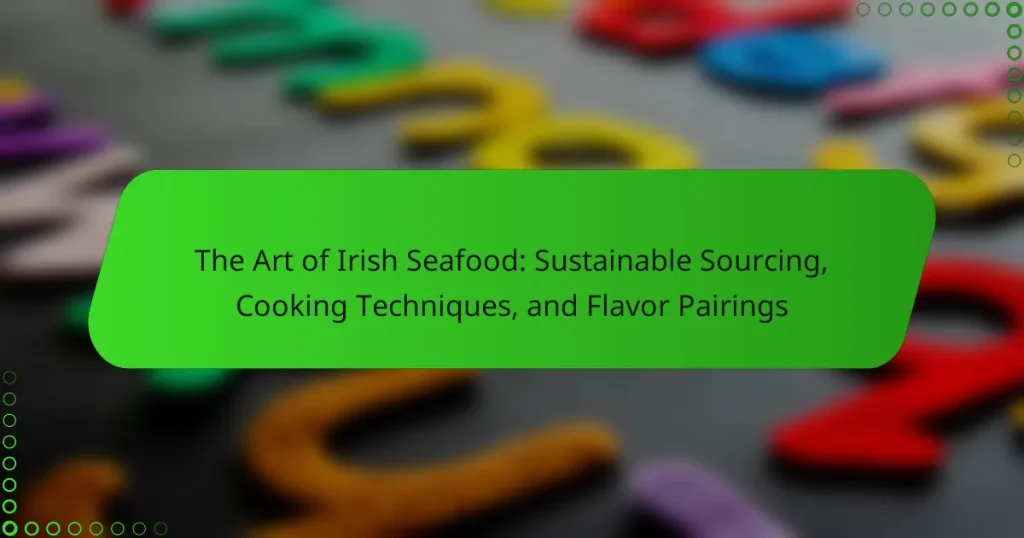The Art of Irish Seafood encompasses traditional and modern practices of sourcing, preparing, and enjoying seafood from Ireland’s waters. This approach prioritizes sustainability through responsible fishing methods and strict regulations that protect marine resources. Key cooking techniques, such as grilling, poaching, and steaming, enhance the natural flavors of the seafood, while local ingredients like citrus, herbs, and sea salt are commonly used to create complementary flavor profiles. Additionally, the article highlights the importance of seasonal sourcing and community involvement in sustainable seafood practices, celebrating Ireland’s rich maritime heritage and the quality of its seafood offerings.

What is the Art of Irish Seafood?
The Art of Irish Seafood refers to the traditional and contemporary practices of sourcing, preparing, and enjoying seafood from Ireland’s waters. This art emphasizes sustainability, ensuring that fishing practices do not deplete marine resources. Irish seafood is known for its freshness and quality, often harvested from clean, cold waters. Techniques such as grilling, poaching, and steaming are commonly used to enhance natural flavors. Flavor pairings often include local ingredients like seaweed and herbs, which complement the seafood. The focus on seasonal and local sourcing elevates the culinary experience. This art celebrates Ireland’s rich maritime heritage and the diverse seafood available.
How is Irish seafood defined and categorized?
Irish seafood is defined as marine food sourced from the waters around Ireland. It encompasses a variety of species, including fish, shellfish, and seaweed. Fish categories include flatfish, round fish, and oily fish. Shellfish is further divided into crustaceans and mollusks. Sustainable sourcing practices are essential for categorizing Irish seafood. These practices ensure that species are harvested responsibly to protect marine ecosystems. The Marine Institute in Ireland provides guidelines for sustainable fishing. This helps maintain the biodiversity and health of Irish waters. Additionally, seafood is often categorized by its culinary uses and flavor profiles.
What types of seafood are commonly found in Irish waters?
Common types of seafood found in Irish waters include cod, haddock, and mackerel. These species are abundant due to the rich marine ecosystem. Shellfish such as mussels, oysters, and prawns are also prevalent. The Irish Sea supports various fish populations, including flatfish like sole and plaice. Additionally, salmon is a significant catch in rivers and coastal areas. The diversity of seafood contributes to Ireland’s fishing industry and culinary traditions. According to the Marine Institute, these species thrive in the nutrient-rich waters surrounding Ireland.
What are the distinguishing characteristics of Irish seafood?
Irish seafood is characterized by its freshness, variety, and sustainability. The cold, clean waters surrounding Ireland provide ideal conditions for rich marine biodiversity. Common species include mussels, oysters, and salmon, known for their exceptional quality. Irish seafood is often harvested using sustainable practices, ensuring the health of marine ecosystems. The flavor profile is influenced by the pristine environment, resulting in a clean, briny taste. Additionally, Irish seafood is celebrated for its high nutritional value, being rich in omega-3 fatty acids and essential vitamins. The commitment to local sourcing further enhances its appeal, connecting consumers with the region’s culinary heritage.
Why is sustainability important in sourcing Irish seafood?
Sustainability is crucial in sourcing Irish seafood to protect marine ecosystems. Overfishing can lead to species depletion and habitat destruction. Sustainable practices ensure fish populations remain healthy and viable. They also support local economies and communities dependent on fishing. According to the Marine Institute, sustainable fisheries management can enhance biodiversity. This approach helps mitigate climate change impacts on marine life. Sustainable sourcing promotes responsible consumption and consumer awareness. Ultimately, it fosters a balance between economic needs and environmental health.
What sustainable practices are employed in Irish seafood sourcing?
Irish seafood sourcing employs several sustainable practices. These include strict adherence to fishing quotas set by the European Union. Fishermen use selective gear to minimize bycatch and protect juvenile fish. Aquaculture operations follow environmental guidelines to reduce habitat impact. Sustainable certification programs, such as Marine Stewardship Council (MSC), are widely adopted. Regular monitoring ensures compliance with sustainability standards. These practices help maintain fish populations and protect marine ecosystems. Ireland’s commitment to sustainability is reflected in its seafood exports, which emphasize ethical sourcing.
How do these practices benefit the marine ecosystem?
Sustainable seafood sourcing practices benefit the marine ecosystem by promoting fish population recovery. These practices help prevent overfishing, allowing fish stocks to replenish naturally. They also protect marine habitats from destructive fishing methods. For instance, using gear that minimizes bycatch preserves non-target species. Sustainable practices enhance biodiversity, which is crucial for ecosystem resilience. According to the Marine Stewardship Council, certified sustainable fisheries have a lower environmental impact. This ensures healthier oceans and supports local fishing communities. Overall, sustainable sourcing contributes to the long-term health of marine ecosystems.
What are the cultural and historical influences on Irish seafood cuisine?
Irish seafood cuisine is deeply influenced by its coastal geography and historical practices. The island’s extensive coastline provides abundant access to various seafood. Traditional fishing methods, such as netting and line fishing, have been passed down through generations. Celtic traditions also emphasize the significance of seafood in rituals and celebrations.
During the Great Famine in the 19th century, seafood became a vital food source for survival. The influence of Norse and Viking invasions brought new techniques and flavors to the cuisine. Irish seafood dishes often feature local ingredients, reflecting the region’s agricultural practices.
Modern sustainability efforts also shape current seafood sourcing and preparation methods. Overall, these cultural and historical factors contribute to a rich and diverse Irish seafood cuisine.
How have traditional Irish cooking techniques evolved over time?
Traditional Irish cooking techniques have evolved significantly over time. Historically, cooking methods included boiling, baking, and roasting. These methods were influenced by available resources and local ingredients. The introduction of modern appliances has shifted some techniques towards grilling and frying. Additionally, globalization has introduced new flavors and cooking styles. Traditional dishes now often incorporate international spices and cooking methods. The focus on sustainability has also changed practices, emphasizing local and seasonal ingredients. Overall, evolution reflects a blend of heritage and contemporary culinary trends.
What role does seafood play in Irish culinary heritage?
Seafood is a cornerstone of Irish culinary heritage. It has been integral to the diet of coastal communities for centuries. Ireland’s extensive coastline provides access to a variety of fish and shellfish. Traditional dishes often feature cod, haddock, and mussels. Seafood reflects the country’s cultural connection to the sea. Festivals and local markets celebrate seafood as a vital food source. The preparation methods are often simple, highlighting the freshness of the ingredients. Historical records show that seafood was a staple in ancient Irish diets.

How is Irish seafood sustainably sourced?
Irish seafood is sustainably sourced through strict regulations and responsible fishing practices. The Irish government enforces quotas to prevent overfishing. These quotas are based on scientific assessments of fish populations. Additionally, many fisheries are certified by organizations like the Marine Stewardship Council. This certification ensures that fishing methods do not harm the ecosystem. Aquaculture in Ireland also follows sustainable practices, focusing on minimizing environmental impact. Farmers use techniques that reduce disease and pollution. Furthermore, local communities are involved in sustainable sourcing initiatives. This collaboration promotes long-term viability of marine resources. Overall, these measures contribute to the sustainability of Irish seafood.
What regulations govern the sustainable fishing of Irish seafood?
Sustainable fishing of Irish seafood is governed by multiple regulations. The Common Fisheries Policy (CFP) of the European Union sets the framework for sustainable fishing practices. This policy aims to ensure that fish stocks are maintained at sustainable levels. It includes regulations on catch limits, fishing quotas, and seasonal closures. Additionally, the Marine Institute in Ireland conducts scientific assessments to support these regulations. The Fisheries (Consolidation) Act 1997 also provides legal guidelines for fishing activities. Compliance with these regulations is monitored by the Sea Fisheries Protection Authority (SFPA). The objective of these regulations is to protect marine ecosystems and promote responsible fishing.
How do these regulations impact local fishing communities?
Regulations impact local fishing communities by enforcing sustainable practices that protect fish populations. These regulations often limit catch sizes and specify fishing seasons. As a result, fish stocks can recover, ensuring long-term viability. Local fishermen may face reduced short-term income due to these restrictions. However, healthier fish populations can lead to more stable fishing opportunities in the future. Studies show that sustainable fishing practices can increase overall fish biomass. This ultimately benefits local economies reliant on fishing. Additionally, regulations can promote community engagement in conservation efforts.
What certifications indicate sustainable seafood in Ireland?
The certifications that indicate sustainable seafood in Ireland include the Marine Stewardship Council (MSC) certification and the Aquaculture Stewardship Council (ASC) certification. The MSC certification ensures that wild-caught seafood is sourced from sustainable fisheries. The ASC certification focuses on responsible aquaculture practices. Both certifications help consumers identify seafood that meets environmental and social standards. These certifications are recognized internationally and provide assurance about the sustainability of seafood products.
What are the best practices for selecting sustainable seafood?
Select sustainable seafood by prioritizing certified options. Look for labels from organizations like the Marine Stewardship Council (MSC) or the Aquaculture Stewardship Council (ASC). These certifications ensure responsible fishing and farming practices. Research the species you intend to buy. Some fish populations are overfished, while others are abundant and healthy. Choose local seafood when possible. This supports local economies and reduces carbon footprints from transportation. Pay attention to seasonal availability. Consuming seafood in season promotes sustainability. Avoid species listed as endangered or threatened. This helps protect marine biodiversity. Lastly, ask your seafood supplier about their sourcing practices. Transparency is key to ensuring sustainability.
How can consumers identify sustainable seafood options?
Consumers can identify sustainable seafood options by looking for certifications and labels. Certifications like the Marine Stewardship Council (MSC) and the Aquaculture Stewardship Council (ASC) indicate sustainable practices. These organizations assess fisheries and farms for environmental impact. Additionally, consumers can consult seafood guides from reputable sources. Guides, such as those from the Monterey Bay Aquarium, provide recommendations on sustainable choices. Checking for local sourcing can also indicate sustainability. Seafood from nearby waters often has a smaller carbon footprint. Lastly, asking vendors about their sourcing practices can provide clarity on sustainability.
What resources are available for finding sustainable seafood suppliers?
Resources for finding sustainable seafood suppliers include online directories, certification programs, and industry reports. Websites like SeafoodWatch provide lists of sustainable seafood options. The Marine Stewardship Council (MSC) offers a certification program for sustainable fisheries. The Aquaculture Stewardship Council (ASC) certifies responsible aquaculture practices. Local seafood markets often have information on sustainable suppliers. Additionally, organizations like the World Wildlife Fund (WWF) publish guides on sustainable seafood choices. These resources help consumers make informed decisions about seafood sourcing.

What cooking techniques enhance the flavors of Irish seafood?
Grilling enhances the flavors of Irish seafood by imparting a smoky char. This technique allows natural oils to seep out, intensifying taste. Steaming preserves moisture and delicate flavors, making it ideal for fish. Baking with herbs and citrus adds depth while retaining freshness. Searing creates a crispy exterior, locking in juices. Poaching in broth enhances flavors without overpowering the seafood. Each technique highlights the unique qualities of Irish seafood, ensuring a flavorful experience.
What are the traditional cooking methods used for Irish seafood?
Traditional cooking methods used for Irish seafood include steaming, grilling, and baking. Steaming retains moisture and enhances the natural flavors of fish and shellfish. Grilling adds a smoky taste, often used for mackerel and sardines. Baking is common for dishes like fish pie, where seafood is combined with a creamy sauce. Boiling is also utilized, especially for shellfish like mussels and crab. These methods reflect Ireland’s coastal heritage and emphasize the quality of fresh ingredients. Historical practices have shaped these techniques, ensuring they remain central to Irish cuisine.
How does grilling differ from steaming in preparing seafood?
Grilling and steaming are two distinct cooking methods for seafood. Grilling involves cooking seafood over direct heat, which imparts a smoky flavor and creates a crispy exterior. This method often enhances the natural flavors of the seafood. In contrast, steaming cooks seafood using moist heat, preserving its moisture and tenderness. Steaming typically results in a softer texture and retains more nutrients compared to grilling. The choice between these methods affects the final taste, texture, and nutritional profile of the seafood dish.
What unique methods are specific to Irish seafood dishes?
Irish seafood dishes often utilize unique methods such as traditional steaming and poaching. Steaming retains the natural flavors and moisture of the seafood. This method is commonly used for dishes like mussels and fish. Poaching, often in court bouillon, enhances the delicate taste of seafood. Ingredients like seaweed are frequently incorporated for added flavor. Another method is grilling, especially for fish like mackerel. This technique imparts a smoky flavor that complements the seafood. Irish cuisine also emphasizes local sourcing, ensuring freshness. The use of seasonal ingredients is a hallmark of these dishes.
How can modern cooking techniques elevate Irish seafood dishes?
Modern cooking techniques can elevate Irish seafood dishes by enhancing flavors, improving presentation, and ensuring optimal texture. Techniques such as sous-vide cooking allow precise temperature control. This method results in perfectly cooked seafood that retains moisture and flavor.
Additionally, techniques like smoking or grilling add depth and complexity to the taste profile. These methods create a unique flavor that complements the natural sweetness of Irish seafood.
Using molecular gastronomy can also transform traditional dishes. This approach introduces new textures and forms, making the dining experience more engaging.
Furthermore, modern techniques often emphasize sustainability. For instance, using techniques that minimize waste aligns with eco-friendly practices.
Research shows that incorporating these methods can increase consumer interest and appreciation for seafood dishes. A study by the Marine Institute highlights that innovative cooking attracts younger demographics to traditional cuisines.
What innovative cooking methods are gaining popularity?
Sous vide cooking is gaining popularity as an innovative cooking method. This technique involves vacuum-sealing food in a bag and cooking it to a precise temperature in a water bath. It allows for enhanced flavor and tenderness, as food cooks evenly and retains moisture. The method has been adopted by both home cooks and professional chefs. Research indicates that sous vide can improve the quality of seafood dishes, making it a preferred choice for preparing delicate ingredients like fish. Additionally, air frying is becoming popular due to its ability to create crispy textures with less oil. This method uses hot air circulation to cook food, providing a healthier alternative to traditional frying. Both sous vide and air frying reflect a trend towards healthier and more efficient cooking techniques.
How do sous-vide and other techniques affect texture and flavor?
Sous-vide and other cooking techniques significantly impact texture and flavor. Sous-vide cooking involves vacuum-sealing food and cooking it in a water bath at precise temperatures. This method allows for even cooking and retains moisture, resulting in tender textures. Foods cooked sous-vide often develop enhanced flavors due to the prolonged cooking time, which allows for better infusion of seasonings and marinades.
Other techniques, such as grilling or roasting, can create different textures. Grilling adds a charred exterior while maintaining juiciness inside. Roasting caramelizes sugars, enhancing sweetness and depth of flavor. Each technique alters the Maillard reaction, affecting both texture and flavor profiles.
Studies show that sous-vide can preserve vitamins and nutrients better than traditional methods. This preservation contributes to a more vibrant flavor. Additionally, sous-vide can reduce overcooking, which often leads to dry textures. Thus, the choice of cooking technique directly influences the overall culinary experience.

What flavor pairings work best with Irish seafood?
Citrus, herbs, and spices are ideal flavor pairings for Irish seafood. Lemon and lime enhance the natural taste of fish and shellfish. Fresh herbs like dill, parsley, and chives add brightness and freshness. Garlic and shallots provide depth and richness to seafood dishes. Sea salt enhances the briny flavors of seafood. White wine complements the delicate flavors in dishes like fish stew. Butter adds a luxurious texture and flavor to seafood preparations. These pairings are commonly used in traditional Irish recipes, showcasing the freshness of local ingredients.
What ingredients complement the natural flavors of Irish seafood?
Citrus, herbs, and spices complement the natural flavors of Irish seafood. Lemon and lime enhance the freshness of fish and shellfish. Dill and parsley add aromatic notes without overpowering. Garlic provides a savory depth that pairs well with various seafood dishes. Sea salt accentuates the natural brininess of seafood. Black pepper adds a mild heat that balances flavors. Olive oil contributes richness and helps to highlight the seafood’s taste. These ingredients are commonly used in traditional Irish recipes to elevate the seafood experience.
How do herbs and spices enhance seafood dishes?
Herbs and spices enhance seafood dishes by adding flavor, aroma, and nutritional benefits. They can balance the natural taste of seafood, making it more appealing. For example, dill complements fish with its fresh, slightly sweet flavor. Thyme adds earthiness, while parsley provides a bright note. Spices like paprika and cayenne introduce heat and depth, enhancing overall taste complexity. Additionally, herbs and spices can increase the nutritional value of seafood dishes. They often contain antioxidants and essential vitamins. Studies show that incorporating herbs can reduce the need for excessive salt and fat, promoting healthier eating.
What are some traditional side dishes that pair well with seafood?
Traditional side dishes that pair well with seafood include colcannon, potato salad, and brown bread. Colcannon is a classic Irish dish made from mashed potatoes and cabbage. It provides a creamy texture that complements seafood flavors. Potato salad, often prepared with mayonnaise and herbs, adds a refreshing contrast. Brown bread, a staple in Irish cuisine, offers a hearty and rustic element. These dishes enhance the overall dining experience with seafood. Their flavors and textures are well-balanced, making them ideal accompaniments.
How can one create balanced and flavorful seafood meals?
To create balanced and flavorful seafood meals, focus on incorporating a variety of ingredients. Use fresh seafood as the main protein source. Pair it with seasonal vegetables for added nutrients. Include whole grains like brown rice or quinoa for fiber. Utilize herbs and spices to enhance flavor without extra salt. Cooking methods such as grilling, steaming, or baking preserve nutrients and taste. Aim for a balance of flavors, textures, and colors on the plate. This approach not only boosts health benefits but also creates visually appealing meals.
What tips can help in achieving perfect flavor combinations?
To achieve perfect flavor combinations, consider balancing contrasting tastes. Pair sweet ingredients with salty or sour ones for contrast. Use herbs and spices to enhance flavors without overpowering them. Freshness is key; use seasonal ingredients for optimal taste. Experiment with textures to create a more dynamic dish. Acidic elements like lemon juice or vinegar can brighten flavors. Additionally, consider the cooking method; grilling can add depth. Lastly, taste as you go to adjust flavors accordingly. These tips are supported by culinary principles that emphasize balance and harmony in cooking.
How do seasonal ingredients influence flavor pairings?
Seasonal ingredients significantly influence flavor pairings by providing fresh and vibrant tastes that enhance dishes. Ingredients harvested at their peak ripeness offer optimal flavor profiles. For instance, summer vegetables like tomatoes and zucchini pair well with light, fresh seafood. In contrast, winter root vegetables complement richer seafood options, such as oily fish.
Seasonal availability also encourages creativity in culinary practices. Chefs utilize local, in-season produce to create unique flavor combinations. This approach not only enhances taste but also promotes sustainability by reducing transportation emissions. Research indicates that using seasonal ingredients can lead to more flavorful and nutritious meals, as they retain higher levels of vitamins and minerals.
Overall, seasonal ingredients shape flavor pairings by dictating what is fresh, available, and optimal for creating balanced, harmonious dishes.
What are some practical tips for cooking Irish seafood at home?
Use fresh, locally sourced seafood for the best flavor. Irish seafood is known for its quality. Clean and prepare the seafood properly. Rinse it under cold water to remove any impurities. Cooking methods like grilling, steaming, or baking enhance the natural flavors. Avoid overcooking, as it can make seafood tough. Pair seafood with traditional Irish ingredients like potatoes or seaweed. This creates a harmonious flavor profile. Season simply with salt, pepper, and herbs. This allows the seafood’s taste to shine.
The Art of Irish Seafood encompasses the sustainable sourcing, cooking techniques, and flavor pairings of seafood from Ireland’s waters. This article defines Irish seafood, categorizes common species, and highlights the importance of sustainability in fishing practices. It discusses traditional and modern cooking methods, as well as ideal flavor pairings that enhance the natural qualities of seafood. Additionally, the article provides practical tips for cooking Irish seafood at home, emphasizing the use of local ingredients and sustainable practices to create balanced and flavorful meals.


